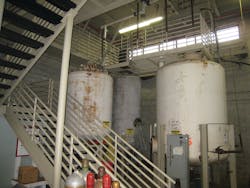As with any form of technical rescue, the potential for success begins with a solid foundation. For example, working within a collapsed building, most shoring starts with a sole plate; Trench stabilization starts with ground pads to stabilize the surrounding soil; and extrication on wrecked vehicles begins with solid stabilization. Rope systems aren’t any different; success on the rope rescue incident begins with a solid, stable platform to begin the operation.
This month discusses simple anchor systems for the first-arriving companies.
Building blocks for anchor systems
A thorough size-up shall be done upon arrival to spot a suitable anchor for the systems to be attached to. Anchors should be considered “bomb-proof”; that is, would the anchor survive a catastrophic shock loading of the system? Positive anchor characteristics would include massive structural steel and concrete, including a mix of both in some structural settings (Photo 1). These are structural components of the buildings; in other words, without these components, the structure would be significantly compromised, or would experience a catastrophic failure. Additionally, the anchor point should be DIRECT AND IN-LINE with the victim (Photo 2). Having the load axially applied to the anchor will provide for the most efficiency and safety; this may mean looking further beyond the incident to find a suitable anchor point that is more in-line than a closer choice. This will have to be done whether the force of the load is applied vertically or horizontally.
When not in the urban environment, the company may have to seek out natural anchor points. These points can be categorized as “BFTs” (Big, Formidable Trees) or “BFRs” (Big, Formidable Rocks). These natural anchors should be checked thoroughly to ensure that they can support the loads expected within the system. However, outside anchoring objects are not limited to natural materials. Emergency apparatus, large shipping containers, massive concrete pillars and blocks can all serve as primary anchors, pending confirmation that the anchor itself can support the intended load on the system (Photo 3 and 4).
A common question when it comes to rescue systems is “What if…?” When setting an anchor, the “What if…” co-efficient should be used. For example, “What if” the anchor was loaded in a different direction? “What if” one leg of the anchor fails? “What if” etc. This question should be met with confirmation that the anchor will indeed support the operation. If the company members find themselves asking that question, and the answer is either “I don’t know” or “The victim will plummet to their demise,” then the proposed anchor is NOT suitable for use in the system (Photo 5).
There are times when there will not be a single anchor point that will be met with confidence regarding its performance. There are times when a few objects could be used in conjunction with one another to form a suitable anchor point. These are referred to as “Pseudo-Anchors”. Good examples of pseudo-anchors can be trees, stair stringers and treads, fence posts, or any multiple points grouping of suitable anchors (Photo 6).
Anchoring materials
Many materials within the rope-rescue world serve well as anchoring equipment. One common device is a nylon anchor sling (Photo 7). Many of these slings can hold considerable weight and can be used in a multitude of arrangements, with the strongest arrangement in a basket setting. These slings come with weight ratings sewn on the tags of the slings.
Another efficient material used for anchoring is tubular webbing. This material can tolerate contact with sharp objects better than rope; however, it is considered best practice to pad all sharp edges when any rope or webbing equipment comes in contact with it. It is also used in the patient packaging arena, serving as tied Swiss seats or pick-off harnesses, as it has a much softer feel against the flesh than rope does. Life safety rope can also be used as suitable anchoring materials, providing a very strong attachment to the anchor object for the operation (Photo 8).
Single-point anchors
Connecting to the anchor can be very simple and efficient, and there are a few options to choose from. A simple, yet strong attachment is the sling and clip, which places the anchoring material in a basket shape around the object. To limit the amount of slip on the anchor object, applying a choker sling around the anchor object limits the vertical travel that the material may experience once the system is loaded. The sling is wrapped from the front, around the anchor object and brought back to the front and connected in the front. A very strong attachment to an anchor with rope is the tensionless wrap (Photo 9), which takes the rope completely around the anchor object a specific number of times (usually at least four to five) and then is knotted at the end and clipped to the standing part of the rope. The strength in this wrap comes from the friction the rope applies to the anchor when it is loaded.
Multiple-point anchors
There are times when the best anchor choice will not be aligned with the victim. When this happens, if a suitable anchor farther back and in line exists, then that would be a good choice. If not, it may be necessary to construct a directional anchor. This type of anchor can combine two or more pseudo-anchors into a suitable anchor system while aligning the anchor with the victim.
Two common types of multi-point anchors are the Self-Equalizing Anchor and the Load-Sharing Anchor. The Load-Sharing Anchor (Photo 10) utilizes two separate slings or ropes around two separate anchor objects. Each sling shares the load equally between the objects as long as the load is aligned in the center of the system. Conversely, the Self-Equalizing Anchor uses two or more anchor points, but all points are connected with one rope or sling (Photo 11). The concept behind the self-equalizing anchor is that, should the load come off-center of the system, the rope would be allowed to move freely between each anchor and equalize the load on the anchor system.
While these anchors are formidable, they do have drawbacks. First, these systems use a considerable amount of rope. Second, the critical angle of the anchor material directly connected to the load should be as small as possible. As this angle increases, the applied load on each anchor component compounds considerably. This can lead to catastrophic failure of the anchor in the event of a shock load to the system.
Conclusion
Without a strong foundation to build from, the rescue operation can become compromised, leading to system failure and injury. There are a lot of factors to consider when choosing an anchor at the rescue scene. Different types of anchors work best with different types of materials. Having a variety of materials in the tool cache will increase the efficiency of the rescue team when operating on scene.
The next article in this series will discuss mechanical-advantage systems and safety/belay systems commonly used in the rope-rescue environment, and how to determine which is best suited for the operation.

Michael Daley
MICHAEL DALEY, who is a Firehouse contributing editor, is a 37-year veteran who serves as a captain and department training officer in Monroe Township, NJ. He is a staff instructor at multiple New Jersey fire academies and is an adjunct professor in the Fire Science Program at Middlesex County College. Daley is a nationally known instructor who has presented at multiple conferences, including Firehouse Expo and Firehouse World. His education includes accreditations as a Chief Training Officer and a Fire Investigator, and he completed the Craftsman Level of education with Project Kill the Flashover. Daley is a member of the Institution of Fire Engineers and a FEMA Instructor and Rescue Officer with NJ Urban Search and Rescue Task Force 1. He operates Fire Service Performance Concepts, which is a training and research firm that delivers and develops training courses in many fire service competencies.






